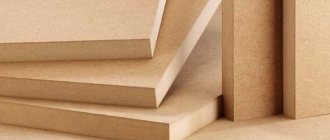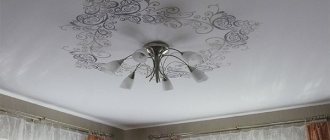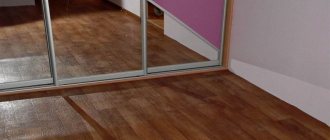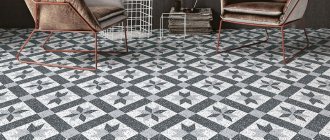Until recently, tiled cladding in corridors was not very common. We are talking about our, domestic realities. It was believed that this material was cold, formal and uncomfortable. As a rule, space was allotted to it only in kitchens and bathrooms. If tiles were laid, it was only in a small area near the front door (in a damp and dirty area). But now everything is different. If you look through designer interiors over the last five years, you will find that tiles in corridors (not in hallways, but in corridors) are almost more common than laminate or parquet.
The attitude towards this material has changed. The main reason is that the tiles have become more interesting. There was simply a stunning selection of colors, designs, sizes, shapes and patterns. For any corridor you can choose a stylish and effective solution.
How to make a technological joint between tiles and laminate
Curves at the point of contact of two floor coverings look beautiful in design projects and in photographs, but they are very difficult to make in real life.
In this lesson we will look at how to make a technologically advanced joint between tiles and laminate on straight and winding areas. Serpentine and complex transitions look beautiful only on projects and cause a lot of inconvenience
- In the hallway and kitchen - so as not to spoil the laminate from moisture and increase the wear resistance of the coating;
- For zoning a room;
- Under the doorway.
Quick navigation through the article
Floor covering requirements
Therefore, the following requirements are imposed on the coating and finishing:
- Maximum wear resistance;
- Moisture resistance;
- Low contamination threshold;
- Strength to mechanical stress;
- Practicality.
Also, you need to pay attention to the appearance and color. But this does not directly relate to the requirements, because all kinds of patterns and shades can be selected according to your tastes and preferences, there is no need to classify them and somehow combine them into something like a list.
You can argue for a long time which is better: tiles or laminate in the hallway. Or you can take and combine two types of flooring. Designers use this technique to visually delimit space without using costly methods.
What does the combination of two types of flooring give? Premises that are exposed to the greatest degree of pollution, such as the hall and kitchen, require different types of coating.
The entrance area of the hallway can be tiled, the rest of the floor - laminate. In this case, there is a visual distinction: dirty and clean.
The lobbies in apartments are often small; the use of different materials for flooring in combination gives the effect of visually increasing the space. The combined floor in the hallway made of tiles and laminate looks stylish.
The photo shows a combination of dark tiles and light laminate in the interior of the entrance area.
To combine laminate and tiles, you need to decide on the method of joining them. There are only three of them:
- Joint joint to joint, without the use of additional decoration elements;
- Docking with the help of moldings will effectively emphasize the contrast of the materials used;
- A cork expansion joint, which is laid at the border of tiles and laminate.
Each of these methods of combining two types of flooring has its pros and cons. For example, using molding in a hallway can allow dirt to accumulate underneath it.
In the hall it would be more appropriate to use the combination of materials using the end-to-end method. With proper delimitation and installation, the gap between the coatings will be no more than 1-2 mm.
READ MORE: Tile on wood floor technology
If you plan to lay laminate boards without gluing, then for a combined floor you can use a cork condenser, which will fix the laminate and prevent it from moving. It is important that the floor has a flat surface for this joining method!
Options for connection nodes
There are several ways to make a technological connection between laminate and tiles:
- Flexible PVC profile - suitable for any curved bends. Consists of a base and a decorative nozzle.
Flexible PVC profile Cezar
Flexible metal connecting profile
Standard aluminum sill
Door frame with threshold
According to the “Manual for the design of autonomous engineering systems of single-apartment and semi-detached residential buildings” (section Ventilation, paragraph 4.84), a gap of at least 2 cm must remain under the interior doors for air flow.
Solid wood profiles and thresholds
Transition profiles smooth out abrupt transitions between two coatings
Installation methods
Let's take a closer look at the installation features of each option.
Cutting tiles and laminate
When the seams between two materials are straight, there are no problems with their fitting, but it is difficult to trim the curved areas. To do this, you will need to make a template from available material (cardboard, polystyrene foam, etc.), using which to mark the future joint.
- A curved cut on laminate is made using a manual or electric jigsaw.
- The tiles can be cut to fit the curves of any shape using a grinder with a diamond tile disc, or manually with a jigsaw/hacksaw with a diamond string. You can also drill as many holes as possible along the cut line and break off the excess with wire cutters.
Installation of flexible PVC profile
Installation instructions for flexible PVC profile
- After laying the tiles and laminate, there should be a gap, the thickness of which will allow you to install the fastening profile and leave a temperature gap of 5 mm next to the laminate.
- Using a hammer drill, we drill holes for dowels in the expansion joint. If you have a heated floor running through the seam, then liquid nails can be used for installation, but it is better to exclude such cases at the design stage.
- We cut off the required length of the profile using a knife/hacksaw/jigsaw.
- We screw the fastening profile to the base with self-tapping screws.
- Before laying the decorative flexible profile, you need to soften it. To do this, place it in warm water (50-70 degrees) for 15-20 minutes.
- The decorative nozzle is inserted into the mounting profile and snaps into place.
Installation of flexible metal profile
- Before starting work, calculate the thickness of the tiles and laminate, taking into account the adhesive and backing - they must match.
- We manually give the required bend to the profile.
- Cut the required length using a grinder or a hacksaw.
- The profile has special claws for attaching it to the floor, so it is best to install it simultaneously with laying the tiles. The foot will be pressed against the tile with glue, and on the other side the backing and laminate will simply be inserted.
The profile is held in place by pressing with the tiles
Installation of aluminum threshold
A regular threshold with holes is installed as follows:
- Cut the threshold to the width of the doorway.
- Mark the drilling points at the joint.
- Drill holes, insert dowels and secure the threshold with self-tapping screws on top.
- To screw in self-tapping screws, use a screwdriver or screwdriver with minimal torque, otherwise the threshold will bend.
An important nuance: the measurement is taken taking into account the platband, and not just between the two extreme points of the box. Then the threshold is trimmed to fit the trim to avoid gaps.
If the threshold has hidden fastenings:
- The holes are marked on the base.
- A self-tapping screw with a dowel is inserted into the groove on the underside of the threshold.
- Holes are made in the floor.
- The threshold with the dowels on is inserted into the holes and hammered to the end. To avoid damaging it, strike it through a block pad.
Instructions for installing a threshold with hidden fastening at the junction of laminate and tiles
To remove the backlash, take a larger dowel and file the head
- Mark the outline of the sill on the flooring to ensure it is glued evenly in the center of the joint.
- Remove the protective film from the self-adhesive base and stick it on.
Hallway floor design
Using laminate for the entire surface of a corridor is not always a practical solution. Therefore, there are alternative options for combining laminate with other materials. Based on the functionality of this area, it is better to combine laminate with tiles.
The tiles can be laid where there is increased load. For example, near the front door. It is better to use porcelain stoneware or ceramic tiles in the hallway. When zoning the space, it is important to remember that the boundary between the laminate and tiles should be clearly defined. Therefore, it is not recommended to choose materials of the same shade.
Combination of laminate and tiles in the hallway.
Expert Yulia Kovtunova (Author, content manager) Work experience: 3 years, since 2020.
The hallway is somewhat limited in terms of combination, which is explained by the clear distribution of the degree of impact load on the floor covering. The patchwork technique is excluded: this way the space will be broken into parts, introducing a feeling of disorder into the corridor.
In order not to doubt how to lay it correctly (lengthwise or crosswise), it is worth taking into account the features of the hallway.
The design of combining textures depends on the skill of the master: if there is no experience, it is better to combine materials using clear straight lines. The installation can look like a tile or laminate backsplash, framed in contrast. If skill allows, the laying lines can be curved or turned, moving into another room or narrow corridor.
To understand what the combination of tiles and laminate is in the interior of a hallway, you can look at the zoning of experienced designers:
- The combination of solar tiles and brown laminate with a board texture, designed with a rounded line and complemented by a rug at the threshold in the same shade as the laminate, looks original;
- an interior in brown and beige tones will sparkle in a new way if you make a rug at the threshold from small soft beige tiles, decorated with floral patterns;
- You can accentuate the ethnic interior with the help of bright color contrasts: you can zone the space with a clear straight line, decorate the threshold with tiles with ornaments, combining them with a dark-colored laminate;
- if you don’t have experience, and the experiment just drags on, you can lay the tiles at the threshold like a ladder: this way it’s easier to do the work by combining two neutral shades using moldings or thresholds;
- the transition of materials can extend to other rooms: tile paths on a beige laminate background look original;
- The combined technique of smoothing out the interior decor is interesting: the contrast of white and beige finishes dilutes the dark spots of the room, making it softer through a curved line.
READ MORE: How to install a toilet in a private house on a wooden floor
Any design project can only be limited by the imagination of the author. To create flooring in a residential area, you can use various combinations of tiles and laminate.
You can play with color contrast, differences in textures and joint relief. The floor in the hallway made of tiles and laminate in the photo is designed in the form of a wave.
To ensure that the color scheme of tiles and laminate does not conflict with each other, there are several simple selection rules.
Neutral colors usually go well together; the seam in such combinations is almost invisible. When purchasing materials, you need to combine them with each other to see the effect of the combination.
It is better to select contrasting combinations taking into account the design of the walls, but you need to remember that the design of the walls changes more often than the floor covering. Therefore, it is worth using classic contrast options that will suit any interior.
The tiles and laminate in the hallway in the photo visually divide the space into an entrance area and a relaxation area.
Since entrance areas most often do not have windows, it is better to choose light shades of laminate, which will make the interior of the hallway visually more spacious and brighter. The tiles in the entrance area may have a darker shade in order to hide marks from street shoes.
There are so many options for combining floor coverings that creating a unique floor design in an apartment or house is not difficult even for those new to renovation.
If choosing materials for flooring is difficult, you can always invite a professional designer who will create an interior design project for any part of the house, taking into account the customer’s wishes.
Laminate is an excellent option for a hallway because it has a long service life. Laminated imitation of natural wooden parquet has become popular for quite a long time. Thanks to its strength and beauty, laminated parquet gradually replaced not only expensive and capricious natural parquet, but also more functional tiles and linoleum from the first positions.
Among the variety of types of boards and their decor, choosing laminate for the kitchen and hallway is not so difficult. It is worth remembering that both of these rooms are places with high traffic, and in the kitchen there is also a special temperature regime: food is being prepared, the air is saturated with moisture and heated by electrical appliances and a gas stove. For such conditions, a laminate needs a special one, waterproof or at least moisture resistant.
All types of laminated boards are conventionally divided by manufacturers into classes. It is believed that laminate classes 21-23 are suitable for home use.
Reviews indicate that, in fact, such a board, which is not highly resistant to moisture, can and should be used in dry, impassable spaces - in the bedroom, children's room, on the balcony or loggia. If desired, class 23 laminate can be placed in the hallway if you live in a region where wet weather is rare and dirt and moisture are not brought in from the street.
In the kitchen it is recommended to lay laminate flooring of at least class 31
Commercial laminate 31-33 is considered suitable for walk-through spaces; it is more resistant to damage and water, that is, a waterproof model, ideal for the kitchen and hallway.
Water resistance or moisture resistance, what to choose:
- A waterproof laminate is one that is not only resistant to moisture, but also able to withstand a flood without the boards swelling or deforming;
- A moisture-resistant laminate will also not swell from spilled drops, but it will not hold a significant amount of spilled water.
A waterproof option is optimal for the kitchen, but it costs significantly more.
If a waterproof laminate is not available for a number of reasons, you can use the principle of combining materials: decorate the working part of the kitchen floor using ceramic tiles or porcelain stoneware, together with the laminate.
Different types of laminate and combining them with other materials make it possible to use such flooring not only in rooms, but also in the kitchen or hallway, where the risk of damaging the boards is quite high.
Laminated boards as a covering in the hallway have many supporters. However, the usual ceramic tiles, which are considered the most practical and functional, also have enough of them. What to give preference in this case?
If the hallway has a high traffic volume of people from the street, then it is better to give preference to tiles, and if it is small, laminate will also work well
Which floors are more convenient for the hallway:
- If we think not in a figurative direction, but in a practical one, then both coatings can be easily removed.
- Tiles are a harder and colder material; if there are small children in the house, it is better to give preference to laminate - it’s warmer to run on, and it won’t hurt as much to fall.
- If fragile decorative elements (vases, statues, floor mirrors) are installed in the hallway or corridor, tiles are also undesirable - the risk of breaking the decorations is quite high.
- But for a hallway where there is always dampness and a lot of dirt is dragged in from the street, tiles will be much more convenient than laminate - they are easier to wipe off and they are not afraid of water at all.
The choice of flooring for the hallway depends not only on your taste preferences, but also on the needs of the room. Choose laminate flooring for dry, spacious hallways, rooms where children will be present, or fragile interior decoration items will be installed. And in places with high traffic, in humid climates, it is worth using tiles. In any case, you can consider combining these materials if you want to use them at the same time.
In many ways, the result of installation depends on what tile is chosen when combining it with laminate. It happens:
- rectangular;
- square;
- hexagonal (honeycomb);
- curly.
If you use tiles in the form of squares and at the same time quite large in size on a small area, this will once again emphasize the cramped space. But rectangular tiles in a narrow corridor, laid crosswise in a striped manner, will make the room more spacious. The most installation options are in the spacious hallway, where you can lay out a real mosaic of multi-colored tiles, harmoniously combining them with laminate flooring.
Diagonal styling looks more original. Thanks to this, unevenness on the floor is perfectly hidden, and the corridor seems wider. However, in order to arrange the elements in this way, you need to have good skills in such work. And to achieve the result, it will take a lot of time, as well as material, since a large number of tiles will have to be divided into parts.
What is better to put in the hallway - tiles or laminate?
The apartment starts from the hallway. This room bears a large and varied load - water, street dust and dirt, slowly melting snow, dampness from drying shoes. All heavy and oversized cargo also ends up here first. What is better to put in the hallway - tiles or laminate so that the floor lasts a long time, resists deformation and abrasion and is beautiful? About this in our article.
Pros and cons of laminate
Laminate flooring is an innovative material that has experienced a boom in popularity over the last decade. Manufacturers are constantly working to improve the properties, correcting the shortcomings inherent in the products.
The main advantage of laminate is its low price, but high-quality samples that can withstand the load of the hallway well are expensive.
What else is good about laminate flooring?
- It is considered the warmest flooring option for an apartment after parquet. It can absorb shock loads due to a well-made screed and a high-quality substrate.
- Does not slip - almost all boards have a texture and roughness that imitates natural wood.
- A large number of colors, textures - panels do not always imitate wood, but can look like ceramic tiles, type-setting parquet, stone.
- Easy to install. Laying the substrate and panels and adjusting them to the geometry of the room is done quickly, without much dust or special skills.
Carpet in the interior: a dust collector or a practical solution?
Carpet invites you to walk barefoot, warms the interior visually and literally, absorbs noise well, and makes any room more comfortable. But for some it evokes associations with the floor in the office. And some even classify such a coating as a dust collector. Let's talk about the pros and cons of carpet in the interior.
There are also serious disadvantages that are relevant specifically when installing in a hallway:
- if water gets into the joints or under the baseboard, the boards may swell and never return to their previous state - the coating will have to be changed;
- due to static electricity, it can attract dust and dirt from shoes, fleecy woolen clothes, coats, etc.;
- a large or medium-sized dog may begin to leave scratches with its claws over time;
- heavy shoes and thin heels contribute to abrasion more than slippers in other rooms.
These disadvantages are typical for inexpensive coatings, so we recommend installing a commercial waterproof laminate of 32–33 classes. It withstands the loads inherent in the corridor much better.
Tile floor in the hallway: combination, advantages, disadvantages
The floor in the hallway is exposed to a lot of unfavorable factors every day, from heels and shoe soles to cleaning products, water, dust, sand and salts brought from the street. For an area that is subject to such loads, you should choose a resistant floor covering.
Tile copes well with serious loads. The unpopularity of this solution is due to the fact that two decades ago the material on the market did not have an attractive appearance, and it was for this reason that they tried to use it only when absolutely necessary. At present, the situation has changed radically. Designing a tile hallway floor solves many problems. The modern construction market is ready to offer everyone a wide range of tiles of various shapes, sizes and design options. Such diversity will allow you to choose a material that will become an integral part of any interior. At the same time, good tiles surpass in their performance properties even the highest quality and most expensive laminate or parquet.
Advantages and disadvantages
The design of modern tiles is very diverse. There are models on the market that imitate the color and texture of natural wood or stone. There are also tiles with an unusual pattern or print. Properly selected material will highlight the strengths of the interior. Moreover, the floor will not lose its attractiveness for many years and will look like new.
Among other things, tile floors are easy to clean and are resistant to chemical cleaning agents and mechanical stress.
But like any other coating, tiles also have their drawbacks. This material is hard and cold; it is not as pleasant to step on as, for example, a wooden board, laminate or carpet. If there is an excess of tile covering, the design of the hallway floor may turn out to be too gloomy and cold. It is for this reason that this material should be used in a small area.
To make the floor reliable and durable, it is enough to tile a small fragment of the room near the threshold, which bears most of the load.
Hallway design with tile floors
Tiles can be used to divide space into functional zones. Using this material, it is advisable to highlight the shoe area, which is located near the threshold. The design of the hallway may include a combined floor finish. Moreover, the use of two types of flooring will visually add free space to the space.
The tiled floor should harmoniously complement the design of the hallway. The ceramic material must be combined with the main floor covering, which in turn must be an integral part of the space.
How to choose a tile
Of course, any tile can be cleaned using aggressive detergents, brushes and abrasives. But in order for the need for such measures to arise as rarely as possible, preference should be given to textured porcelain stoneware in dark shades. You should also pay attention to the color of the grout. The joints of the slabs also become dirty over time and cleaning them is not always easy.
Glazed and polished porcelain stoneware slabs look impressive. However, they can be dangerous because their smooth surface does not prevent slipping.
It would be better to opt for textured surfaces that will fit well into the design of the room.
Combining two floor coverings
As noted above, tiles in the hallway are all appropriate material, but only to a limited extent. As the main floor covering, it is better to use parquet, laminate or, for example, linoleum. At the same time, the tiled area can be either on the same level with the floor or slightly rise above it. It should be noted that such an elevation should not exceed 3-5 centimeters, otherwise such a design move can turn the hallway into a very dangerous place. An elevation or podium can be made using a screed mortar or even regular tile adhesive.
The allocation of a shoe zone also has a functional meaning: none of the owners and guests will go outside the limits designated by the zone in dirty shoes.
The connection of two types of flooring can be linear and shaped. The first method provides straight lines of joints and requires less effort to implement. When creating a shaped border of coatings, cutting slabs and making simple calculations may be required. But additional efforts will be rewarded with the original appearance of the interior.
Designing a figured joint should not cause difficulties or problems. You can easily find flexible docking thresholds that can take any shape. It is much easier to work with straight joints, especially since the range of joining parts for them is much wider. In this case, the joining threshold can match the color of the tiles, baseboards, furniture fittings or the main floor covering. This approach will make the hallway design harmonious and laconic.
dekormyhome.ru
Advantages and disadvantages of tiles
Tile is a much more expensive type of finishing. It can be made of different materials - ceramics, porcelain stoneware or PVC with various additives that increase strength. Moreover, the latter is easy to install, does not require special construction skills and can be replaced individually, without destroying the surrounding coating.
The advantages include:
- resistance to water, dirt, ease of cleaning;
- resistance to external damage – especially porcelain stoneware;
- Stylish appearance - tiles can also imitate parquet boards; you can choose from a large assortment of models for any room design.
Imitation of natural materials in tiles
Today in interior stores you can find a large number of tiles imitating natural materials. In this article we will talk about how to choose the right styling, what you should pay attention to, and what interior styles this finishing option will fit into.
The main disadvantages of tiles are the high cost and complexity of installation. Given the non-standard dimensions of most rooms, you may need a tile cutter, which will make installation quite dusty. Also, tiles tend to be quite cold, so walking on them barefoot can be unpleasant (unless you use an underfloor heating system).
These disadvantages are irrelevant when using PVC tiles: they are lightweight, easy to install, however, like other coatings, they require high-quality surface leveling.
Types, characteristics
The material for finishing surfaces is a product of clay firing. More often, due to its resistance to water, it is used in toilets and bathrooms. However, tiles can be used to decorate any room.
The walls after cladding are quite strong and can easily withstand any mechanical stress. Advantages: long service life, ease of cleaning. Characteristics are acquired by firing the material under pressure.
Due to their high density, the tiles are resistant to frost and moisture. According to the manufacturing method, porcelain stoneware is divided into two classes:
- Class A – smooth surface without imperfections. The end pieces are cut correctly.
- Class B is manufactured under high pressure. Size and shape may vary slightly.
Floor decoration
According to the ability to absorb liquid falling on the finishing material:
- The first class absorbs less than 3% moisture. Suitable for bathrooms, swimming pools, toilets.
- II A-Class is filled with moisture up to 6%.
- II-B class absorbs up to 10% water.
- III class – 10% or more.
The class and resistance to aggressive substances are indicated by the manufacturer on the packaging. When cleaning, detergents and cleaning agents with a high or low hydrogen index of the environment are often used. To indicate stability, letter markings are used. A is the maximum indicator, D is the minimum, it is allowed to clean only with clean water.
On the packaging, you need to additionally study the markings for the purpose of the tiles. There should be an image of a hand for the walls.










